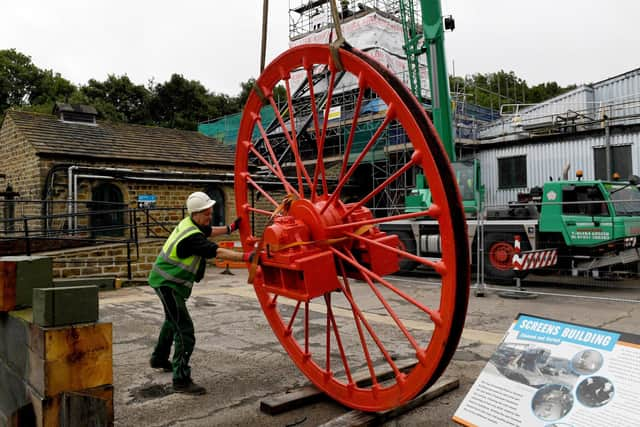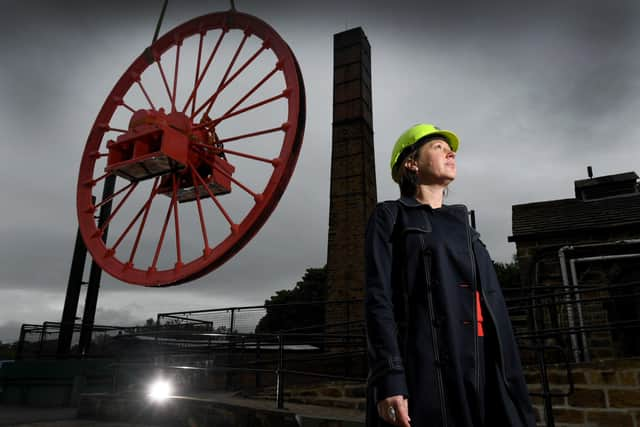Last wooden winding wheel hauled back into place at Wakefield’s mining museum
As the newly restored wooden winding wheel was hoisted back into place at Caphouse Colliery near Wakefield, those in charge admitted that not even they knew how it had survived.
But after a Government-funded restoration programme, it will serve as a bridge to the past for a new generation of visitors.
Advertisement
Hide AdAdvertisement
Hide AdTimber headstocks such as the one at Caphouse – which is now home to the National Coal Mining Museum – were outlawed in 1911, though not retrospectively.


By the time the pit closed after the miners’ strike of 1984 it was probably the only one in the Yorkshire coalfield not to have been replaced by a steel lattice structure.
“Why this one wasn’t done as well is a very good question,” said the museum’s mine director, Shaun McLoughlin.
“What we do know is that it dates from between 1905 and 1911, which was when new legislation was passed. All new headgear after that date had to be made of metal.”
Advertisement
Hide AdAdvertisement
Hide AdIt has taken six months to replace the rotting pine in the 10ft diameter wheel, which used to haul the rope-drawn cage that transported miners and materials up and down the 460ft shaft from the surface to the coal seam. However, its purpose since Caphouse reopened as a museum has been ornamental and symbolic, not functional.


But Mr McLoughlin said it was a structure of such historic importance that when he took up his post four years ago he set in train a rescue project, bringing in conservation specialists to preserve its historical integrity and restore it to its former glory.
The museum director, Jenny Layfield, said its restoration had “not only prevented the further degradation of a historically important structure but opened up new ways to tell the story of mining”.
The wheel is now capable of being turned by the old steam winding engine, as it was in its working days, for demonstrations to visitors, Ms Layfield said – but for the moment it would serve as a beacon to welcome visitors back to the museum when it reopens on August 5. .
Advertisement
Hide AdAdvertisement
Hide AdThe restoration job had been a huge undertaking, Mr McLoughlin said, and not least for the crane operator, who shortly after dawn yesterday had to position the giant wheel exactly on to two supporting beams around 30ft off the ground.
Such headstocks were the “welcome signs” that told returning wanderers from each of the old pit villages that they were home.
Their development before the industrial revolution arose from the need to exploit coal seems deep underground, and the first winding wheels were horizontal and horse-drawn.
Pitch pine headstocks like that at Caphouse – which is now Grade II* listed – were typical of those in the late 19th century, before it was discovered that the wood was prone to rotting.
Advertisement
Hide AdAdvertisement
Hide AdLess than half a mile away, the pit head at Hope Colliery, which led down to the same seam, was a steel job. But elsewhere, some private pit owners got around the concerns by building steel frames over the wooden ones.
Editor’s note: first and foremost - and rarely have I written down these words with more sincerity - I hope this finds you well.
Almost certainly you are here because you value the quality and the integrity of the journalism produced by The Yorkshire Post’s journalists - almost all of which live alongside you in Yorkshire, spending the wages they earn with Yorkshire businesses - who last year took this title to the industry watchdog’s Most Trusted Newspaper in Britain accolade.
And that is why I must make an urgent request of you: as advertising revenue declines, your support becomes evermore crucial to the maintenance of the journalistic standards expected of The Yorkshire Post. If you can, safely, please buy a paper or take up a subscription. We want to continue to make you proud of Yorkshire’s National Newspaper but we are going to need your help.
Advertisement
Hide AdAdvertisement
Hide AdPostal subscription copies can be ordered by calling 0330 4030066 or by emailing [email protected]. Vouchers, to be exchanged at retail sales outlets - our newsagents need you, too - can be subscribed to by contacting subscriptions on 0330 1235950 or by visiting www.localsubsplus.co.uk where you should select The Yorkshire Post from the list of titles available.
If you want to help right now, download our tablet app from the App / Play Stores. Every contribution you make helps to provide this county with the best regional journalism in the country.
Sincerely. Thank you.
James Mitchinson, Editor
Comment Guidelines
National World encourages reader discussion on our stories. User feedback, insights and back-and-forth exchanges add a rich layer of context to reporting. Please review our Community Guidelines before commenting.